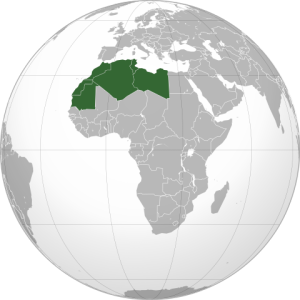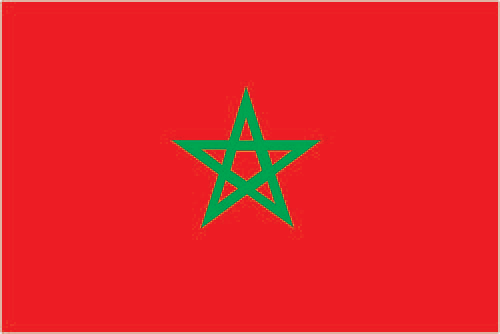Last updated on April 18th, 2022
Morocco is a North African country with beautiful scenery, fascinating history and lots of culture, including delicious cuisine, to explore. With these 65 interesting facts about Morocco learn about its history, geography, culture, tourism, economy, people, food, and lots more.
Facts about Morocco’s history
1. Historic evidence suggests that Morocco has been inhabited by humans since the Paleolithic era of prehistoric times. The Maghreb (as the Northern Africa area is called) was a fertile savannah then and not at all like today’s modern arid landscape.

2. In still ancient, but more recent, history Morocco has been occupied by the Romans, Vandals, Visigoths, and Byzantines. Morocco and the rest of North Africa were drawn into the emerging Mediterranean world by the Phoenicians as they established settlements and trading colonies. The earliest known independent Moroccan kingdom was the King Bocchus I, a Berber of Mauretania.
3. There was apparently a famine in the country in 1520 that killed many people. One woman who wrote about it described it this way: “. . . a famine in Morocco so terrible that for a long time other events were dated by it.” Whether or not that famine was real, there have been suggestions that Morocco’s population dropped from 5 to under 3 million between the early 16th and 19th centuries.
4. The year 1549 saw the beginning of the rule of a succession of Arab dynasties all claiming direct descent from the great Islamic prophet Muhammad (P.B.U.H.) The Saadi Dynasty was succeeded by the Alaouite Dynasty, who assumed power in the 17th century.
5. Sultan Mohammed III established the Moroccan-American Treaty of Friendship in 1786. As the American Revolution began, the country’s Atlantic Ocean merchant ships were being attacked by Barbary pirates. On December 20, 1777, the Sultan declared that all American merchant ships were now under his protection and thus could enjoy safe passage. Therefore, Morocco was the first nation to recognize the newly formed country of the United States formally as an independent nation. This treaty today is the U.S.’s oldest non-broken friendship treaty.
6. As Europe industrialized, North Africa was increasingly prized for its potential for colonization. France showed a strong interest in Morocco as early as 1830, not only to protect the border of its Algerian territory, but also because of the strategic position of Morocco on two oceans. In 1860, a dispute over Spain’s Ceuta enclave led Spain to declare war. Victorious Spain won a further enclave and an enlarged Ceuta in the settlement. In 1884, Spain created a protectorate in the coastal areas of Morocco while France and Spain carved out zones of influence in Morocco.
7. Morocco gained their independence in 1956 and has a history of being a prominent and independent regional power, a history not shared by their neighboring countries. King Hassan II assumed the throne in March of 1961 but never established a democratic republic. Human rights abuses were investigated during his reign and some 592 Moroccans were reported to have been killed.
8. Morocco laid claims to the territory of Western Sahara, leading to a war that continued until a cease-fire agreement was reached in 1991. The standoff continues today. The Moroccan government refers to this area as its Southern Provinces.
Flag of Morocco

9. Today Morocco is a constitutional monarchy with an elected parliament. King Mohammad VI, who claims to be directly descended from the prophet, holds vast legislative as well as executive powers.
10. Morocco celebrates their national holiday of Throne Day on July 30 each year, which celebrates and honors the accession of King Mohammad VI to the throne in 1999.
Geography
11. The Northern African country of Morocco, officially named the Kingdom of Morocco, is situated between Algeria and the annexed Western Sahara (the Southern Provinces). It borders both the Mediterranean Ocean and the Atlantic Ocean, one of only three countries in the world that do (the others being France and Spain). Its borders with Algiers have been closed since 1994.
12. Morocco is geographically characterized by its two mountain ranges, the Atlas and Rif Mountains; its portion of the Sahara desert; and its beautiful coastal areas. Many think of the arid Sahara as being the typical North African landscape but it’s the green mountains to the north and beyond where most Moroccans make their livelihood in the fertile coastal plain.
Map of Morocco
13. The Atlas Mountains form the backbone of Morocco, running from the northeast of the country down to the southwest, and are in fact three distinct ranges. These divide the country into sections at different altitudes: the Middle Atlas, Anti-Atlas and High Atlas. They run from the city of Agadir into Tunisia and Algeria.
14. In the High Atlas Mountains are many Berber villages, terraced on small ledges and preserving their ancient culture. These are the highest and most dramatic of all Morocco’s mountains and their highest peak is Jebel Toubkal, topping out at 4,167 meters (2.6 miles) high.
15. The Rif Mountains in the north of the country are also inhabited by the Berber people. They stretch from the northwest of Morocco to the northeast, bordering the Mediterranean ocean. Home to the endangered Barbary macaques, this region receives more rainfall annually than any other part of Morocco.
16. The Sahara Desert covers most of the southeastern portion of Morocco so this region is not only sparsely populated but not very productive economically for the country. More people live to the north and to the south in the Western Sahara, in the former Spanish Colony, Morocco annexed as its Southern Provinces in 1975.

17. The Moroccan coast by the Atlantic reaches up through the Strait of Gibraltar and on into the Mediterranean Sea. Spain is only 15 miles away across the Strait. The Canary Islands (belonging to Spain) are to the west in the Atlantic Ocean.
18. The capital city of Morocco is Rabat. The largest city is Casablanca. Other major cities include Fes, Agadir, Oujda, Tangier, Marrakesh and Nador. Its main port city is Casablanca.
19. The High Atlas are easily accessed from Marrakesh, about 40 minutes away, and also offer wonderful mountain retreats, rustic but full of local character and set amidst stunning scenery.
20. Agadir is located at the foot of the Atlas Mountains a little north of where Morocco’s Sous River enters the ocean.
Economy
21. Morocco’s economy is governed by supply and demand and is today considered fairly liberal, as it has privatized some economic sectors which used to be controlled by the government.
22. Morocco is in the top five African economies by its GDP and a few years ago ranked as the first by the quality of life index of the Economist Intelligence Unit. Today it has the fifth largest economy in all of Africa.
23. Morocco was once a member of the African Union but removed its membership in 1984 when the AU let one of the Western Sahara disputed territories enter as a member. However, Morocco once again joined the African Union in January 2017.
24. Morocco is, however, a member of the Arab League, Arab Maghreb Union (UMA), the community of Sahel-Saharan States (CEN-SAD) and the Organization of Islamic Cooperation (OIC) plus the United Nations. Morocco has been granted major non-NATO ally status by the United States government as well.
25. Morocco has had strong economic and political ties to the West. France and Spain are Morocco’s primary trade partners, as well as their primary foreign investors and creditors. The EU’s European Neighborhood Policy (ENP), which aims to bring its neighbors and the EU closer, includes Morocco.
26. Morocco’s economy is heavily reliant on its natural resources, as are many African economies. Its major resource is phosphate, used in many pesticides, fertilizers, and animal feeds. Industry and mining contribute almost a third of their yearly GDP. Their Western Sahara (Southern Provinces) contains almost two-thirds of the earth’s potential reserves of phosphate. Other Moroccan minerals include cobalt, barite, lead, and fluorspar.
27. The other major Moroccan resources are agriculture and tourism. Top exports include citrus fruits such as tangerines (named after Tangiers), clementines, and mandarins; oranges; tomatoes; and olives. They also export leather goods and textiles.
28. Though the majority of Morocco’s electricity is generated from coal, the government has an initiative underway to build a solar thermal energy power plant. They are also exploring the use of natural gas. Morocco is the largest energy importer in the MENA region.
29. Tarfaya Wind Farm in Morocco is the Africa’s largest capacity wind farms with 131 wind turbines and a total installed capacity of 301 MW. The Morocco population suffers from unemployment and a large external debt, but they do make considerable income from tourism.
30. Cannabis is grown in the Rig Mountains and according to the French Ministry, 80 percent of the hashish consumed in Europe comes from here.
Facts about Moroccans and their culture
31. Morocco has an ancient and rich civilization and culture. Morocco’s distinct culture is a blend of many influences, including indigenous Berber, Sub-Saharan African, Arab, and European influences. All have affected the country’s social structures. Morocco considers it a priority to preserve its cultural heritage. Recently it has even successful incorporated some Anglo-American influences.
32. More than half of the Moroccan population lives in towns or cities. There a man’s social life includes going to a café to meet friends or watch television (particularly football/soccer). Women fill the traditional Islamic female role of tending the family and the home. A recent revision of the family law code of Mudawana due to changing attitudes has granted women more rights. Woman can now have custody of their children and the first wife must approve before a man may take a second one.
33. The predominant religion in Morocco is Islam. Most people are Sunni Muslims. Any Moroccan who is sherfa (believed to be a descendant of the Prophet Muhammad) is given the title Lalla, Sidi, or Moulay.
34. Morocco’s official languages are Berber and Arabic. The people also speak Moroccan Arabaic (Darija) and French is used in government, media and international commerce as well as substantial sized companies. Many Moroccans also speak Spanish.
35. Since Morocco gained its independence, it has undergone a blossoming in the arts: sculpture and painting, amateur theatre, filmmaking, and music. Regular productions of French and Moroccan dramatic words are offered at the Moroccan National Theatre. Music, as well as art festival, are held throughout the summer months. One is the World Sacred Music Festival at Fes. Andalusian classical music evolved under the Cordoban Moors.
36. Morocco’s architectural styles range from clean, simple lines to ornate designs in bold colors, influenced by the indigenous Berbers as well as Moroccan religion and culture. Arab, Portugal, France, and Spain, as well as Islam and the Berbers, have influenced Moroccan architecture.
37. Buildings common to Moroccan cities include mosques with beautiful minarets (towers), bazaars (market areas), medinas (old medieval sections) and Kasbahs (old fortresses). They are often built of traditional adobe (sand, straw/manure, and clay) and stone. Many rural villages have no piped water or electricity.

38. School is mandatory for children aged seven to 15 but children who work with their parents might not be able to attend. Many girls never receive an education. The national literacy rate among adults is 50 percent. French is required to be taught in all schools.
39. There health care is scarce as there are 6.46 physicians for every 10,000 Moroccans.
40. Morocco’s chief of state since 1999 is King Mohammad VI. He has brought the country closer to democracy, but it is still a Muslim state based on Islamic law.
Continue reading on the next page…
